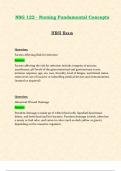NSG 122 - Nursing Fundamental Concepts HESI Exam Question: Factors Affecting Risk for Infection Answer: Factors affecting the risk for infection include: integrity of mucous membranes, pH levels of th e gastrointestinal and genitourinary tracts, immune response, age, sex, race, heredity, level of fatigue, nutritional status, stress level, use of invasive or indwelling medical devices and immunizations (natural or acquired) Question: Abnormal Wound Dra inage Answer: Purulent drainage is made up of white blood cells, liquefied dead tissue debris, and both dead and live bacteria. Purulent drainage is thick, often has a musty or foul odor, and varies in color (such as dark yellow or green), depending on the causative organism. Question: Pressure Ulcer Stage 1 Answer: A stage 1 pressure injury is a defined, localized area of intact skin with nonblanchable erythema (redness). Darkly pigmented skin may not have visible blanching; its color may differ from the surrounding skin. The area may be painful, firm, soft, warmer, or cooler as compared to adjacent tissue Question: Pressure Ulcer Stage 2 Answer: A stage 2 pressure injury involves partial -thickness loss of dermis and presents as a shallow, open ulcer or a ruptured/intact serum -filled blister Question: Pressure Ulc er Stage 3 Answer: A stage 3 pressure injury presents with full -thickness tissue loss. Subcutaneous fat may be visible and epibole (rolled wound edges) may occur, but bone, tendon, or muscle is not exposed. Slough and/or eschar that may be present do not o bscure the depth of tissue loss. Ulcers Question: Pressure Ulcer Stage 4 Answer: Stage 4 injuries involve full -thickness tissue loss with exposed or palpable bone, cartilage, ligament, tendon, fascia, or muscle. Slough or eschar may be present on some pa rt of the wound bed; epibole, undermining, and/or tunneling often occur Question: Wound Infection Answer: Symptoms of infection include purulent drainage; increased drainage, pain, redness, and swelling in and around the wound; increased body temperature ; and increased white blood cell count. Additional signs and symptoms include delayed healing and discoloration of granulation tissue in the wound Question: Braden Scale Answer: Braden Scale: mental status, continence, mobility, activity, and nutrition Using the Braden scale (VHMMN) Lower to 9 Very high risk -V 10 to 12 High risk -H 13 to 14 Moderate risk -M 15 to 18 Mild risk -M 19 to 23 indicate No risk -N Question: Heat Application Answer: The application of heat accelerates the inflammatory response to promote healing. The application of local heat dilates peripheral blood vessels, increases tissue metabolism, reduces blood viscosity and increases capillary permeability, reduces muscle tension, and helps relieve pain. Vasodilation increases local blood f low. In turn, the supply of oxygen and nutrients to the area is increased, and venous congestion is decreased Careful on large parts of the body Question: Dysnpea Positioning Answer: High Fowler's Position because accessory muscles can easily be used to promote respirations




